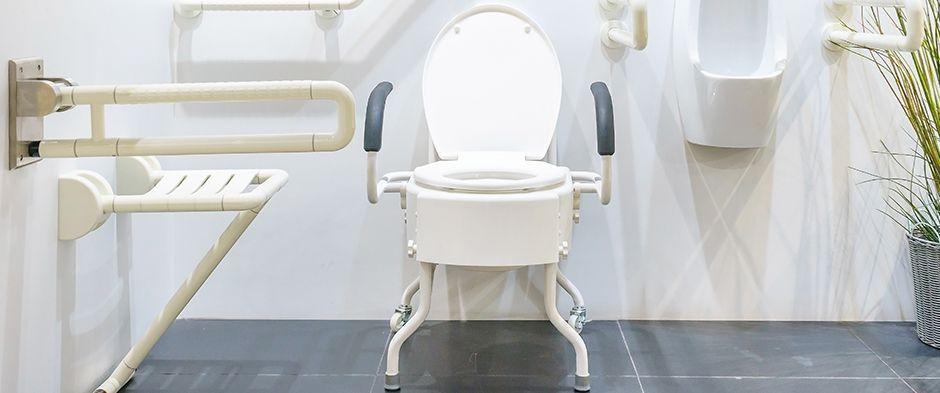
A Guide to Simple Bathroom Aids for Disabled or Elderly People
Sally Madeley-Carr, OT24 Mar 2020
Retaining independence regardless of physical impairments is a key goal for most people, regardless of their age. While certain disabilities and age related conditions present challenges, it's important to realise that there is an ever increasing number of assistive products available to make everyday tasks that bit easier.
While these can help all over the home, it is perhaps in the bathroom where they are most effective. Being able to wash yourself and use the toilet unaided makes a huge difference both in a practical sense and from a psychological point of view. By using the right equipment and by being aware of the products available, it's possible to reduce the chance of requiring help and reduce risk of harm.
Many disabilities result in reduced strength, flexibility, balance and coordination, making it more difficult to undertake day-to-day tasks in the bathroom. Sometimes it's just the routine things, the ones previously taken for granted, which become difficult.
Toileting is one such area which can become problematic. Using a toilet frame or raised disabled toilet seat might just help. We'll come to those later. First we'll go through some common bathroom and toileting aids now available.
Standing at the sink
Using a perching stool at the sink is a great way of making sure you stay balanced and supported. These stools are much higher than standard models and have sitting surfaces which slope gently from back to front.
This allows you to semi-sit on them, with most of your body-weight supported but with your feet still flat on the floor. With your legs only bent slightly at the knee, you're almost at full height, enabling you to use the mirror, wash your face in the sink or brush your teeth.
Perching stools have the great advantage that they allow the user to keep their arms and hands free. Models are available with leg and armrests to provide additional support.
If you do feel unsteady while standing at the sink, you might also consider fitting a grab rail next to it. These provide a reassuring point of support within easy reach, should you lose balance.
Getting to those hard to reach places
Long-handled tools are available which help if you have difficulty reaching certain parts of your body to wash. Some have flexible shafts which can be bent into the desired shape. This helps them reach over the shoulders, for example. Some are fitted with scrubbers or foam heads.
Long-handled brushes and combes are also available from essentialaids.com, helping you reach your hair without having to reach too far upwards.
Not being about to reach one's feet, either because of a disability or just through losing one's flexibility in old age, is a common problem. Long-handled scrubbers are great for this purpose, as are Essential Aids' long handled toenail scissors.
Upturned scrubbers with floor-fixing suckers on the bottom work well in the shower to reach the soles of your feet. They let you clean your feet without needing to bend down.
Flannel straps are great washing aids which help you scrub your back without having to reach behind you. Holding the strap at each end, you use it as you would a towel to dry your back.
Lotion applicators are innovative devices which have long handles and a compartment in the head which releases the shower gel as you scrub the body.
Bath and shower mats
If you feel unstable in the bathroom, it's important to keep any chance of slipping to a minimum. The good old fashioned bath or shower mat can really come in handy.
Essential Aids does a great range of mats in various dimensions, all designed to make hard, wet surfaces less slippery.
Grab rails
Rails fitted in strategic places in the bathroom are key bathroom disability aids. They provide support when using the toilet, getting in and out of the bath, the shower or at the sink.
Some rails are available with a textured surface, making them easier to establish a firm grip when wet.
Available in many different lengths and designs, support rails are great if you are unsteady on your feet, or have reduced strength and balance.
Rails can be in fixed positions on the walls, to the bath itself, or fitted as drop-down units which fold up when not in use.
As with all permanent installations, Essential Aids strongly recommends the use of qualified tradesmen to do any fitting.
Toilet frames
An alternative to fitting grab rails next to the toilet is to use a toilet frame. These box-like structures fit around the pedestal, providing support for your hands as you lower yourself or raise yourself.
They are adjustable in height and in some cases width, so you should be able to find one to fit your toilet.
Some toilet frames have a built-in seat, while others require you to sit on the standard seat. These are generally higher than a standard toilet, meaning there is less distance of travel from a standing position.
Raised toilet seats
Raised toilet seats are also available without a surrounding toilet frame. This variety fixes either to the existing seat or toilet bowl.
Many people with physical impairments find it easier to use a toilet if they are not forced to sit on a low pedestal. A simple device to raise it can make all the difference, especially in combination with a grab rail.
Raised toilet seats usually have clamps, providing solid attachments so they're not prone to slipping. A disabled toilet seat like this is available in different heights, so you should be able to find one to suit your needs.
Shower chairs and stools
If you have difficulty standing for the duration of a shower, you might consider a free-standing or fold-down shower seat.
These provide an easy way to avoid having to stand up for your shower. If you're unsteady on your feet or have reduced physical strength, this simple piece of equipment can make a big difference.
Most models have drainage holes which reduce the amount of standing water on the sitting surface, helping reduce the chance of slipping.
Fold-down models are great space savers, but need fitting by a qualified tradesmen. Smaller free-standing stools are almost all made from aluminium and plastic , keeping their weight down for moving in and out of the cubicle.
There are also perching stools available for shower cubicles, but check you have enough space because they have a larger than average footprint.
Floor-level shower trays and wet rooms
For wheelchair users, a fully adapted home would ideally include a wet room or a shower tray which is completely level with the floor. This allows easy access for the chair, provided it is suitable for wet environments.
Essential Aids supplies a range of high quality wheeled shower chairs, made of non-corrosive materials.
In an ideal world, a bathroom designed for a wheelchair user would have a lowered sink and numerous grab rails.
It might also have u-shaped drop-down rails on both sides of the toilet. Low controls for the shower, within easy from a low position also make a big difference.
Bath seats
These are low seats which fit inside the bath itself. By raising the height of the bath's floor, it gives the person less distance of travel in order to get in.
Bath seats are usually used in combination with a support rail either fitted to the side of the bath or the wall itself.
Some designs suspend the seat across the width of the bath, resting on the horizontal sides, while others sit on the bottom of the bath.
Most bottom-resting models stick to the bath's floor by means of large suckers.
Bath boards
If you don't have a walk-in shower but do have one over the bathtub, you might consider using a bath board.
These provide a solid bridge across the top of the bath on which to sit, if you find it difficult standing for the length of the shower. They clamp to the sides of the bath, keeping them stable and secure.
Some bath boards are fitted with a handle at one end, which gives a useful point to grip on to as you climb in or out of the bath.
They are available in various sizes, so you should be able to find one suitable for your bath. Like shower stools, they tend to have drainage holes to reduce the chance of water build-up on the surface.
Bath lifts
If you have a severe disability or compromised mobility to the extent that you can't get in and out of the bath unaided, a bathlift might be the answer.
Numerous designs are on the market, all of which are designed to lower you into the bath and raise you out of it again.
Transfer boards and benches
If you are using a wheelchair, a smooth transfer board is useful. These act as bridge to help get from a wheelchair onto the toilet or into the bath.
You would require the help of a carer to do this safely.
A transfer bench again creates a bridge from outside the bath to inside it. Typically they have a long seat section, with two legs outside the bath and two inside it.
The idea is to use the bench to edge yourself across the bath side so you end up over the bath itself.
Walk in baths
These baths have 'doors' which allow the user to enter and exit without having to get over a high bath side. Most have a moulded interior seat which allows you to maintain an upright sitting position.
Once inside, close the watertight door behind you and then fill up the bath so the water level raises around you as you sit.
To exit, the water has to drain away first before you can reopen the door.
Other helpful bathroom aids
There are many other use pieces of equipment which help with everyday tasks in the bathroom and don't require fixing in the same way as a grab rail or a disabled toilet seat.
Some of the most useful are simple reaching aids. These have gripping jaws at one end and handle and trigger at the other.
They are great for picking up towels, clothing or other small items from the floor. This type of aid is particularly useful for people who have difficulty bending down - a common problem in old age.
A tap-turner is another useful device which helps you twist taps without needing much strength. These are helpful for those with reduced grip strength or a tremor. They work by increasing the leverage you are able to apply to the taps.
Those with arthritis in the hands and fingers often find them especially useful. For people in this situation, gripping a toothbrush can also be uncomfortable and even painful, mainly because of its narrow handle and the tight grip it requires.
Essential Aids supplies foam tubing which fits over the toothbrush handle, building it up and making it more comfortable to hold.

Sally Madeley-Carr, OT
Sally qualified as an Occupational Therapist in 1996 and is a well-respected professional in the field of rehabilitation equipment and living aids. She has worked in private practice and within the NHS, developing a broad experience with adults and children. Click here for Sally's registration with the Health and Care Professions Council. The HCPC regulates health, psychological and social work professionals in the UK.